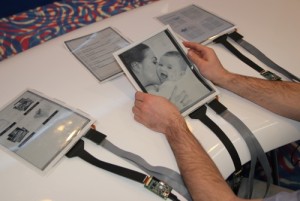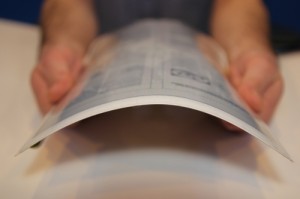
If you’re reading this on a computer, take a moment and look around your monitor or laptop screen. Do you see any stray pieces of paper, such as articles with highlighted passages, notes to yourself, or contact details to follow up with later? Me too. It seems that even after more than thirty years of widespread use, personal computers still haven’t completely replaced paper as a way of displaying and manipulating information. So can they? Should they? Members of the Human Media Laboratory (HML) at Queen’s University have been asking themselves this question for almost a decade. Last week at the Consumer Electronics Show, they unveiled a new prototype – dubbed PaperTabs– which they hope will provide part of the answer.
The story begins in 2004, in those dark ages when hand-held tablet PCs were still (mostly) science fiction. At that time, the HML team was imagining ways to overcome what they saw as one of the PC’s biggest limitations: the screen. “The limited screen real estate on computers requires windows,” says Roel Vertegaal, professor of human-computer interaction at Queen’s University’s School of Computing and director of the HML. “Separating off a limited set of pixels on one display can become very cumbersome when you have many different task environments.” I know the feeling; I generally have dozens of browser windows open at once, and it can be maddening trying to find the one that’s suddenly started playing an annoying ad spot. Paper, on the other hand, makes use of our species’ inherent ability to file things based on proximity and touch. “This whole idea of hot documents that you hold in your hand, warm documents that are nearby and cold files which are further away in your desk or in your file folder really became an operating metaphor,” says Vertegaal.
The team’s first attempt to explore this idea – called PaperWindows – used projectors and advanced tracking technology to turn actual pieces of paper into interactive task environments. Although it may seem clunky by today’s standards, the above video (which actually predates YouTube) demonstrates a system by which documents could be manipulated by rotating the paper vertically or horizontally, and transferred from one sheet to another by touch. “Having multiple displays allows you to multitask more efficiently,” says Vertegaal. “One of the reasons why people print out on paper still is because it allows you to compare documents, copy from one document to another and read while annotating. You can have many tasks stacked on your desk as kind of reminders, which you can easily grab and load into your mind, so to speak.” But projectors aren’t easy to pick up and carry, and they don’t work well in outdoor lighting. The team had to wait almost ten years for science to come up with another solution.

Enter Plastic Logic, a British company that manufactures bendable, interactive displays. Their technology, which is based on a backplane of plastic electric transistors and the same E Ink technology used in the Amazon Kindle, is the only kind in the world that allows for displays the size of traditional A4 (8.5” x 11”) sized paper. Instead of rotating, the displays are fitted with sensors that detect bending or folding, allowing users to access the inherent hapticity of paper. “I can pick up a PaperTab window and hit a button by folding the display, all without actually looking looking at it,” says Vertegaal. “I challenge you to do that on a computer screen.” By enabling us to use senses beyond sight, the HML team hopes that PaperTab will make computers into more of an extension of the body than is currently possible with screens.
It remains to be seen whether we’re ready to toss out our printers and sticky notes just yet. But there is precedent for HML’s imagination becoming reality: this year saw Samsung develop a prototype bendable phone very similar to the PaperPhone HML debuted in 2011. “What we do is basically predict what interactions will look like five to ten years from now, and building them with the technology we have today,” says Vertegaal. “Because we’re creating buzz and talking to the Samsungs and Nokias of the world, we are actually influencing that future. As Alan Kay said, the best way to predict the future is to invent it.”
No comment yet, add your voice below!